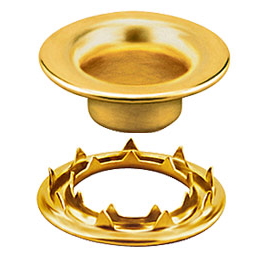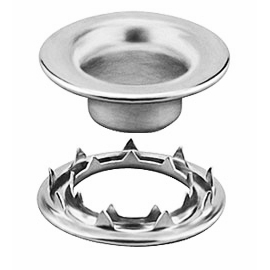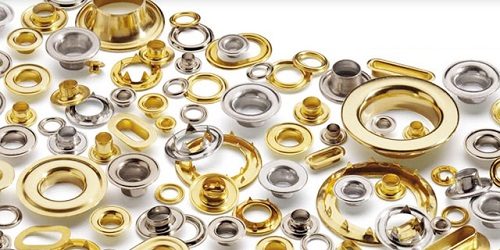

Metal choices are often made on the basis of their respective qualities as detailed below, and less on aesthetic concerns. Though there are often differences in appearance between the silver-colored metals, they are often subtle and may differ depending upon natural variances in the product obtained from our raw material vendors.
BRASS – (70% copper, 30% zinc or 65% copper, 35% zinc)
Also known as “cartridge brass”, this material is easily our most popular for a number of reasons. Brass is anti-microbial, non-magnetic, does not rust, can be plated or painted, and is easier to set than many other materials due to its strong, yet malleable, nature. Perhaps most importantly, however, Stimpson parts made from brass are more likely to be in stock than those made from other materials.
Please note that brass does tend to tarnish over time due to its high copper content but, unlike rust, tarnish does not jeopardize the integrity of the part, making it a popular choice for outdoor environments.
STEEL – (C1008/C1010)
Stronger and typically more economical than brass, steel is a popular choice for cost-conscious customers and those who require its magnetic qualities. However, steel’s high iron content makes it susceptible to oxidation (rust), especially in applications exposed to harsh elements and/or moisture. Many customers will opt to order their steel parts plated to inhibit the rusting process. It’s worth noting that un-plated steel parts are always delivered with an oil-based rust inhibitor which must be removed before any type of finish can be applied.
ALUMINUM –
Aluminum is a soft, light material, but not quite as durable as steel or brass. Its surface oxidizes over time, creating a slightly dull haze which acts as a protective coating over the part. Aluminum also tends to be less expensive than brass. And though aluminum cannot be electro-plated, it can be anodized or painted (enameled).
ZINC –
Similar in appearance to aluminum, zinc is a soft, alloyed, white metal. It is non-magnetic and will not corrode except in extremely hostile environments. It also may offer a slight cost savings over brass on our more popular items. Zinc items cannot be electro-plated.
STAINLESS STEEL –
A hard, slightly magnetic, rust-resistant metal, stainless steel is the strongest material Stimpson offers. However, due to its hardness, some customers may experience minor splitting in the coil after setting eyelets and grommets made from it. Stainless steel cannot be electro-plated.
OTHER COPPER-BASED ALLOYS –
Certain Stimpson parts are offered in less common copper alloys such as “low brass” (80% copper, 20% zinc), “rich low brass” (85% copper, 15% zinc), “gilding metal” (95% copper, 5% zinc), and “copper” which, predictably, contains no zinc. As these alloys get progressively higher in copper content, they tend to become softer (more malleable), redder in color, more expensive, and more electrically conductive.

